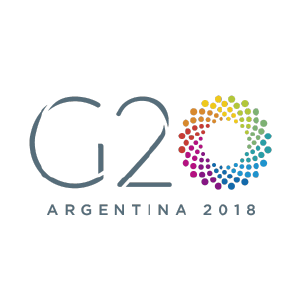The G20’s year-cycle for 2018 was inaugurated in November the 30th 2017, having Argentina as the 2018 presiding country for the major global forum of international cooperation. Lasting over a year, around 60 working sessions will gather Chiefs of State, high rank public officers, and multilateral organisms’ representatives in a discussion over economic, financial, and political current matters.
In numbers, the G20 is constituted of 20 developed and emerging countries, as well as the European Union. Spain is in this case in a permanent guest and two countries are invited by the host, this time having Chile and New Zealand nominated by Argentina. Altogether, these countries accumulate 85% of the world’s GDP, 66% of its population (accounting for 4.500 million inhabitants), 75% of world’s commerce and 80% of global investments.
Leaders from regional and international organisations will also participate in these meetings: António Guterres (United Nations’ Secretary-General), José Ángel Gurría (OECD’s Secretary-General), Christine Lagarde (IMF’s Managing Director), Luis Alberto Moreno (IDB’s President) and Jim Yong Kim (World Bank’s President).
Besides meetings held by Sherpas, public officers and representatives from the international organisations, Affinity Groups encounters will also take place.
These groups are divided in 7 topics: Business 20 (international business community); Civil 20 (having as chair and co-chair Poder Ciudadano and RACI, respectively); Labour 20 (unions); Science 20 (science related matters); Think 20 (gathering experts from around the world); Women 20 (linking civil society organisations focused on women with leading women entrepreneurs); and Youth 20 (platform for the visibilisation of young voices). Each affinity group will deliver recommendations for the G20 to take into account in discussions and further negotiations.
Traditional topics in discussion are fiscal policy, development, and fight against corruption, incorporating more recently sustainable development, global health, and women’s participation in the labour market.
Nevertheless, certain priority topics are determined and maintained throughout the years, giving some sort of consistency thanks to the troika’s definition, which was integrated by the previous presiding country (Germany), the current one (Argentina) and the following nation (Japan).
In its 2018 presidency, Argentina determined the “future of work”, “infrastructure for development” and a “sustainable food future” as priority topics for this edition.
These topics will be discussed in 60 meetings, divided in two channels of work: Finance Channel and Sherpas’ Channel (name given to the representatives of the G20 leaders). The first channel will consist of 11 meetings gathering ministers of finances and central bank presidents treating topics of financial order, while the Sherpa Channel will foster 41 meetings between Sherpas and ministers.
Accordingly, each Affinity Group will have specific occasions to meet, as well as countries representatives in the Leaders’ Summit, in which Chiefs of State are expected to collaborate in the implementation of recommendations following discussions.
At least 52 of the previously mentioned meetings will be held in Argentina, with the remaining ones spread across multiple international summits such the World Banks and the IMF’s. The Argentine government has created the G20 Technical Unit in order to coordinate these meetings, pointing at a better collaboration between State sectors.
An estimate of 13.000 people will participate in meetings previous to the Summit, from which 2.700 will be high rank officials (Sherpas, ministers, second rank officials, and experts such as sub-secretaries and directors), joined by 8.000 technical advisors. Impressively enough, the Leaders’ Summit is expected to gather 7.000 attendees.
For more information, check: https://www.g20.org
Sources:
http://www.apertura.com/economia/Los-numeros-detras-del-G20-20171124-0010.html

